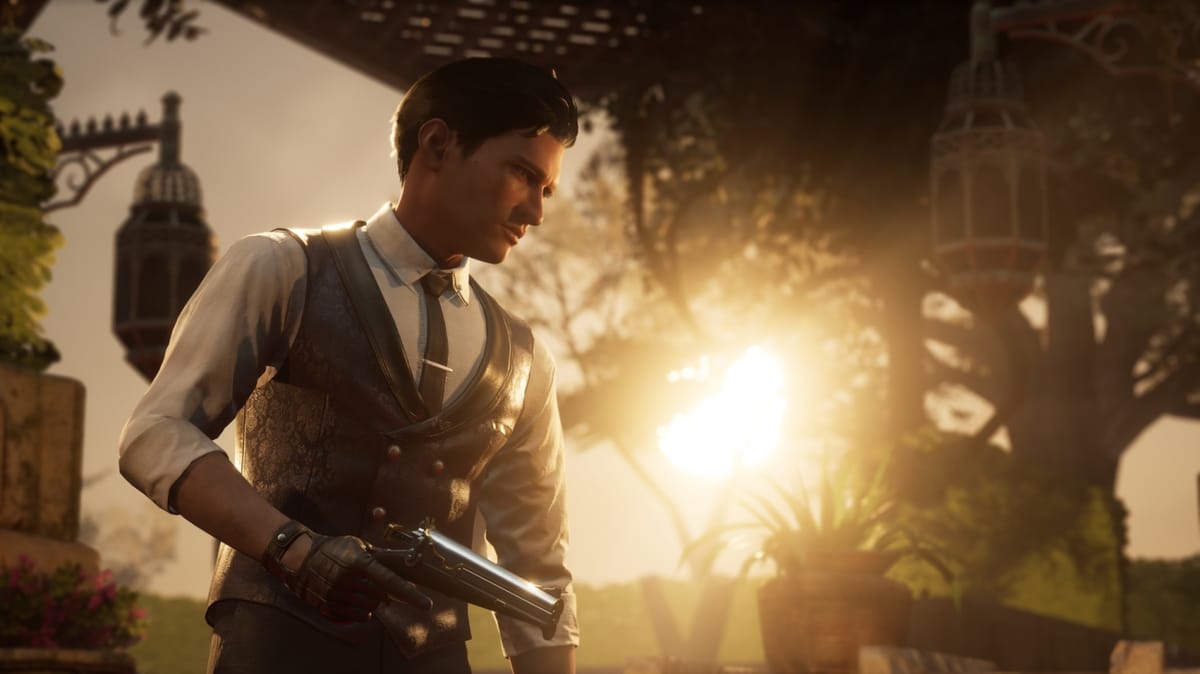
Our pop culture is an incredible thing. Especially nowadays when we have so many things out there to reference, it’s amazing that certain characters haven’t completely disappeared from our view. Some items obviously have staying power, like Star Wars and Marvel, but one that has had impressive staying power is Sherlock Holmes. We’ve gotten plenty of variations of him, between books, tv shows, and movies, and while everyone claims they’ve got the best one, they’re all great in their own way. Not to be outdone, Sherlock Holmes has made his way into the video game realm, with developer Frogwares starting on it nearly twenty years ago. Each iteration has only gotten better, and in their newest version in Chapter One, a unique tale unfolds in arguably the ultimate Sherlock Holmes experience.
Probably my favorite thing about Sherlock Holmes: Chapter One is that it takes place in Sherlock’s early adulthood, and the writing for his character is perfectly depicted here. There’s a recklessness to him, and while he’s still calculated in how he approaches everything, this youthful exuberance leads him into social trouble quite often. We’re obviously used to Holmes being somewhat detached to those around him, after all, he’s on another level, but watching it from this period of his life it feels a bit more arrogant. The learned tact that appears from time to time later in later depictions is definitely missing.
Tying into this version of our super sleuth is his reasoning for making a trip back home to the island of Cordona. Sherlock’s past is often the subject of recent media, and Frogwares is going after this as well, with the current objective centering around the Holmes abandoned abode and the mystery behind the passing of Sherlock’s mother, Violet Holmes. While other stories will certainly feature on the stage, this is the headliner. Frogwares breaks this up in a very practical way, allowing different areas of the house to trigger certain memories to lead you in pursuit of the overarching goal, and each main story mission on Cordona connecting you back to it. The interesting way Sherlock is walled out of the different parts of the house is more than just finding a tool or key to open, he has put up mental blocks that keep him from making his way forward. It sounds somewhat cheesy, but it is an understandable predicament; for whatever reason, Holmes has repressed what has happened to his mother and is afraid of what he might find.
This obstacle is not going to be solved in a little room, and the dev team has gone above and beyond to create what I believe to be Sherlock’s first open world foray. The entire isle of Cordona is at your disposal, and at any time you can just enjoy a nice walk around, exploring and learning new things as you go. Speaking of exploration, Chapter One does a decent job of sending you around when following trails, although I never once ended up in the Miner’s End section of the map because of the main narrative. That blip aside, as you complete the story you’ll largely have new cases and side stories pop up, some directly given (like the police bulletin board) and others popping in as you pass certain landmarks or places, many times being a snippet of Sherlock’s childhood. Let me just say this, Cordona feels perfectly sized; it’s not super small and seemingly like the bare minimum effort was put in, and it’s not so large in lending itself to my getting lost or annoyed with too much on my plate. It’s the little bear’s porridge from Goldilocks– It’s just right. There are also handy fast travel points at carts around the map, and they’re decently spaced out to allow you to get close enough to your objective without a ton of walking after activating them the first time.
Now, if I were to tell you a new Sherlock Holmes game was coming out, you’d expect a deep and involved story, and that’s exactly what you get when playing Chapter One. I’ve always loved games that skew heavily to dialogue and decision making, and this one feels like an elaborate puzzle game. There’s always something to fit together as you go through each case. The primary cases you’re going to encounter in Chapter One are very meaty, with multiple parts spanning different parts of the city. Most have a unique feel to them, although all end up attached by the most atrocious of all sins: murder. Where these succeed is giving you a distinctive change of setting, so even though you might be doing a lot of the same things, it seems different enough to feel fresh. I love all of the main and side cases, although the one involving the occult in the end feels a bit too over the top. Even though Sherlock Holmes and the occult kind of go together like two peas in a pod.
The way Chapter One gets to the point of the narrative utilizing the gameplay works tremendously. Everything largely feels like it flows, which is what I want playing something of this nature. To get from beginning to end, you’re going to have to click on clues, use your “detective vision” to see past what’s in front of you as well as recreate crime scenes, change between different disguises to make it into different areas, the whole shebang, and more! The amount of effort put into the tools and abilities of the game is admirable, and while several of them have been staples of the Sherlock Holmes games, each one great in its implementation. All of them besides one; the detective ping. It does what it needs to, highlighting points of interest in the environment you may or may not have seen, but it doesn’t do a lot when you’re walking around trying to find an obscured object since it only shows you the same dot you usually see, but in yellow if untouched.
That brings me to one of my hang ups with Chapter One, even if it only occasionally rears its ugly head. The series has largely attempted to allow us to be the detective, and that’s appreciated. But for someone playing this without the assistance of YouTube, there are moments where you’re just completely stuck. Maybe you’ve missed a clue somewhere, maybe you forgot to pin a different clue, could be you’re missing something right in front of you, but it happens every once in a while. I wish there were some sort of hint system (beyond the ping), that could be implemented to help the player along just a little better. No handholding is completely fine, but if I’m completely stuck I’d prefer a little more accessibility.
Putting everything together is very much the point of what you’re doing in Chapter One, and I’ve had a lot of fun doing it. Discovering a patch of blood you’ve deduced has come from the person you’re looking for on the ground, using “detective vision” to follow it to a bandit hideout, getting into a gunfight to clear them out, only to find the victim dead would be a real bummer of an ending, but finding the important book he hid in his prison cell to keep it out of the wrong hands leaves you feeling satisfied. Solving a case feels rewarding, as it should. Where the game goes even further however is that there isn’t just one way in the main cases to do that. You’re presented with the Mind Palace, a returning idea from previous games, where you piece together the definitive facts you’ve found. You know Mr. Blank died because of something, so getting the rest of the information to make an accusation is key. This all leads to Chapter One having incredible replayability, with the ability to return and make different decisions in these primary cases.
If there was anything I could tell a new player that is absolutely essential to playing Chapter One, it would be to pay attention to everything. This extends past just listening to dialogue, to your casebook and the environment around you. As mentioned before, progress can stall if you don’t understand what you’re doing or if you miss a single clue, so turning over every leaf is important. The casebook is an incredibly useful tool in figuring out what you’re doing, as specific markers will tell you if you should be using detective vision, talking with bystanders, or changing into a disguise. I found in my first preview I would get hung up way too often, and it was literally because of not paying enough attention to what I was doing and needed to be doing. With the environment, just making sure you’ve touched everything that needs to be touched is key, and between that and the casebook it’s simple to continue forward.
Continuing forward is something you could say is the motto behind Chapter One, and this extends to Sherlock’s companion, Jon. This isn’t Dr. Watson mind you, but a friend from Holmes’ childhood. While I don’t want to get into his character too deeply (you need to discover that secret for yourself), Jon adds a lot of emotional depth to Chapter One that is beneficial to the storytelling. His presence really opens up the psyche of one of the world’s greatest detectives, and this “peeling back of the curtain” so to speak humanizes Sherlock, and while it’s been done before Chapter One is one of the best representations of it in my opinion.
Let me tell you, once you reach the end of the story surrounding Violet Holmes, you’re going to be left mouth agape and possibly in tears from its emotional climax. I truly hope Frogwares doesn’t abandon this particular variant of Holmes in future games, because I feel like I connect with him in this adventure in a way I didn’t in the others. A lot of it just has to do with the character development projected throughout the narrative, and if this is what I can expect from future Sherlock Holmes games, count me in.
One of the newest additions to be included in Chapter One is combat. While somewhat present in previous games, it’s never been as intricate as it appears in this one. Intricate may be a bad word to use, as it’s nowhere near as refined as other third person shooters, but it’s surprisingly fun for something that seems like it should feel tacked on. Sometimes in the story you might encounter a den of baddies, and only in these rooms will you run around, shoot back, and try to intelligently apprehend these foes. Well, mostly, given Sherlock can certainly still shoot to kill. Using environmental options like shooting a bag of flour or shooting their hat off are options you have to disorient them, leading to a quick time event you can initiate within a time limit to “put the cuffs on”. Combat can actually be turned off, so those who only want the detective experience have an option, but I suggest leaving it on.
Before we finish solving this case, I do have to talk about some of the technical limitations, although I do have some praise to give. Reminder: Frogwares Sherlock Holmes games exist in the AA space, so I’m not expecting a Horizon Zero Dawn level of graphical fidelity. That being said, for what it is Cordona shines pretty brightly, and Sherlock and many of the people you’ll personally encounter are modeled very well, along with a stellar vocal performance by Alex Jordan. Where the issues come into play is generally with frame rate on PlayStation 5. I had a lot of stuttery moments, so it’s definitely not running at a clean 60. Another area is pop in, which can happen from time to time, and lastly the reusing of character models (Paul from A Gilded Cage was also a bandit who wanted me dead) along with NPCs that aren’t really that fleshed out. Of all of these, the frame rate is the problem that disappointed me the most.
Sherlock Holmes: Chapter One
Great
Sherlock Holmes: Chapter One is an exemplary experience for anyone wanting to enjoy time with our eccentric investigator. The story behind Violet Holmes' demise will pull at your heartstrings, and the cases you’ll decipher on the way there just make you appreciate Chapter One all the more. Yeah, there are some technical issues, and you’re most likely going to get stuck at least once, but unraveling the best laid plans of the most conniving criminals is a delight to accomplish.
Pros
- Deep, fascinating story
- Sherlock as a young adult
- The open world of Cordona
- Replayability
Cons
- Getting stuck
- Framerate stutters



